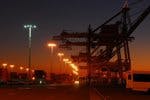Ironically, at SALC in New Orleans in 2011, the conference seemingly ignored anything other than LEDs, as we pointed out in an article in our sister publication LEDs Magazine (www.ledsmagazine.com/features/8/10/7). The 2012 event in Miami held September 10-12 dedicated the bulk of Monday afternoon to a discussion of the options in sources including ceramic metal halide (CMH), induction, and light emitting plasma (LEP).
CMH advancements
Perhaps the bigger deal, however, is in efficacy where Salpietra said the latest CMH products deliver 120-130 lm/W. While that efficacy level is in the same range as HPS sources, the lighting industry has mostly accepted that human scotopic and mesopic vision is much better under broader-spectrum white light than under the yellow- or orange-tinted HPS light with a very narrow spectral distribution.
Street-light retrofits are an area where Salpietra believes CMH presents a solid financial case, and he described several potential scenarios. He started with the potential to simply upgrade light quality replacing an HPS lamp with a CMH lamp and retaining the HPS ballast. Such a retrofit could happen in the ongoing HPS lamp replacement cycle while delivering more light on target with improved visibility, albeit no energy savings.
The latest CMH lamps also can provide an energy-efficiency upgrade for existing MH and CMH lamps. Salpietra suggested that you can replace a legacy 250W MH lamp with a 220W CMH lamp, retain the ballast and still save 15% energy while also realizing 2.5 times the rated life of the lamp. The savings are compounded when you add a more-efficient ballast to the scenario. And Salpietra said that today a 220W CMH lamp and new ballast can effectively replace an older 400W MH light.
Induction sources
Nancy Clanton of lighting design firm Clanton & Associates followed with a presentation focused primarily on induction sources. Clanton, like Salpietra, also works with LEDs. So the discussion wasn’t about induction being superior in every case, but about where induction fits well. Clanton said that you need to “compare LEDs with induction and see where the best applications are for each.”
According to Clanton, induction can match LEDs in terms of lifetime with 60,000 hrs possible. As with LEDs, system design is critical in induction life. Clanton said a good design will separate the generator and power coupler, provide good heat sinks for both, and ensure good airflow through the luminaire. She said higher wattage induction products above 150W can be prone to failure.
Induction lights offer a number of positive characteristics said Clanton. They are inherently low-glare sources, can be smoothly dimmed, are instant on products, and have many years of reliability testing data behind the technology.
The downside of induction lighting is light control. The larger light source can’t be controlled for precise beam control the way total internal reflector (TIR) optics can control the pattern from LED point sources. So you can’t get precisely defined light patterns on roadways, and backlight control is difficult.
Clanton described induction lighting as providing a “blob of light.” But then she said, “When I’m looking at an intersection, maybe a blob is better.” Clanton said the best applications are those with relatively low mounting heights such as crosswalks and parking garages. She noted that the city of Boulder, Co has been very happy with an induction installation in pedestrian areas that was done ten years ago.
Light emitting plasma
Moving from legacy sources to new technologies two speakers addressed the potential for plasma-based sources, or the technology that Luxim specifically refers to as LEP. First physicist Graeme Lister of Ceravision reviewed the basics of all lighting technologies and pointed out that plasma isn’t new. Moreover he said that from a physicist’s point of view technologies such as HPS and LED are very similar in that you combine particles to produce photons.
What’s new according to Lister is the commercial viability of an electrodeless plasma source based on a ceramic object with a cavity in which plasma can be excited by a high-frequency RF signal. Ceravision calls their technology high-efficiency plasma (HEP), and Lister said it offers numerous advantages including a relatively fast start and restrike period, and relatively good dimming support. But the biggest advantage is that plasma can be realized as a relatively small point light source that, like LEDs, is controllable with properly-designed optics.
Marine terminal case study
Ports America is the largest operator of marine terminals in the US including container terminals and terminals that handle items such as automobiles. The terminals are typically 100-200 acres in size and are generally lit today with high-mast lighting on poles as high as 150 ft, with each pole having as many as 12 HPS fixtures mounted in a rosette at the top.
But HPS lights aren’t ideal. According to Ward, the issues are light pollution, excessive energy use, poor light quality and visibility, and poor durability. LEP offers the potential of providing far better visibility with ten times the durability, negligible light pollution, and much better visibility.
Ward first addressed why LEDs aren’t a good match for the application. He said that to get the required light output, LED-based lights would need extremely large heat sinks that would make them heavier than HPS lights. Moreover the marine-terminal application needs a large illumination field. He said that the pole might be 225-ft from the edge of the wharf yet the application requires 2 fc at the wharf edge with no glare in any pilots’ eyes guiding ships to the wharf. Ward said LEDs can’t now achieve that requirement.
Ports America has been testing LEP lighting at its Outer Harbor Marine terminal in the Port of Oakland, CA. The 175-acre facility has 107 high-mast poles with eight to 12 luminaires per pole. There are 1000 total luminaires that require 1 MW of power. The HPS fixtures each cost more than $800 per year to operate just in electrical cost. The company also has to replace each lamp and ballast annually.
Ward’s team has conducted an extensive comparison of the LEP lighting relative to brand new HPS fixtures. The results are encouraging for the LEP technology. Generally the LEP lighting provides better contrast on the ground with almost no light pollution. Ward said, “The HPS is glaring in every direction imaginable.” About the LEP he said, “We have good uniformity and a sharp cutoff” and attributed those results to the point light source.
The tests have generated detailed photmetric plots, but the results summary is quite simple. The HPS fixtures generate more photopic light. The LEP lights deliver more scotopic light and better uniformity. The LEP fixtures cost $2350 per fixture – almost double what the HPS fixtures cost. But the LEP fixtures use less than half the power and are projected to have a 50,000-hr repair interval – more than ten times that of HPS. Ward said that in an HPS retrofit, the payback period for the LEP lights is projected at two and a half years. On a new construction project, that payback period is just one year relative to the HPS option.
The Bright Light Systems fixtures are also equipped with wireless controls and dimming capability. Ward said that the LEP fixtures can be operated at 50% power level and generate only 20% of full light output, He thinks that dimming may be an option in down times when the lights simply serve security purposes, but Ports America isn’t using dimming at this time.
The SALC talks highlighted here make it clear that designers should consider a broad array of light-source technology when contemplating projects. Of course there was plenty of talk about LEDs as well, and they will continue to play a prominent role in outdoor lighting. We will cover the SALC presentations focused on LEDs in the November/December issue of LEDs Magazine.










